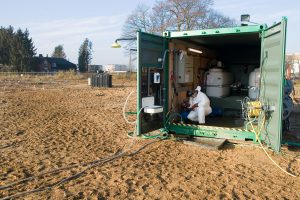Challenge
This former business site was seriously contaminated with chlorinated hydrocarbons, mineral oils, asbestos and heavy metals. This site is located in an intra-urban environment and had to be cleaned up as part of a redevelopment plan. This site was intended to be used for housing in the future. HMVT took care of the remediation plan and its execution for a guaranteed result.
The project started in 2007 and the active remediation activities were completed by mid‑2009. The remediation objectives were formulated as follows:
Above ground: remediation in such a way that the results meet the requirements of ‘home with a garden’.
Below ground: core remediation with a stable end situation as a result.

Solution
The less mobile contaminants mineral oils, heavy metals and asbestos above and below ground were removed by means of excavation. In the soil and groundwater the contamination with chlorinated hydrocarbons was cleaned up using a combination of chemical oxidation and stimulation of natural degradation.
Chemical oxidation was carried out using hydrogen peroxide in accordance with the Fenton’s reagent principle. We carried out multiple oxidation rounds. At some sub-locations a single oxidation round was sufficient, whereas at others four oxidation rounds were necessary.
Once we had removed the bulk of the contamination using chemical oxidation, the biological degradation of the remaining contaminants was stimulated by means of a shock load injection of carbon source: ENNA.
Results
Source location
• Soil excavation approx. 4,000 tonnes
• Drainage and water purification 100 m3/hour (strippers connected in series) during soil remediation
• Chemical oxidation with Fenton’s reagent (three rounds), approx. 190 filters
Soil vapour extraction, approx. 60 filters
• Stimulation of anaerobic biology, approx. 220 filters
Plume
• Size approx. 250,000 m3 soil volume, depth to 18 metres below ground level
• Monitoring for a period of 10 years
• Fallback scenario: biobarrier


